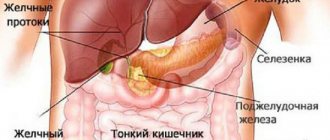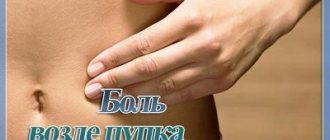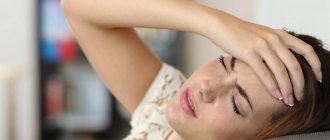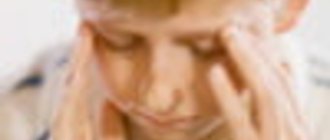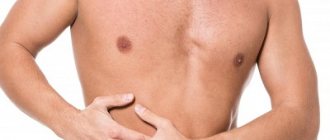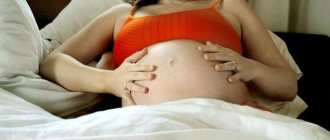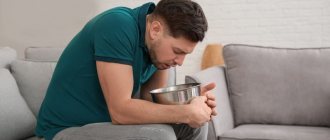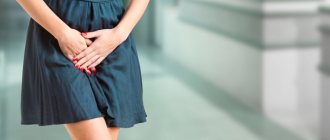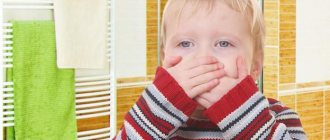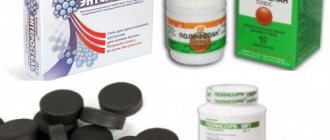Content
- Possible causes of headache (with or without vomiting)
- What should parents pay attention to? Frequent headaches in infants
- For a child 5-7 years old
- For a child 7-10 years old and older
Headache is one of the most common complaints in children of all ages. It is not a disease, but only a symptom. Often headache attacks in children appear in preschool age, around the age of 6 years. They are shorter in duration than in adults. At the same time, children have a complete headache, and at the same time their stomach.
Reasons for the development of a symptom complex
Headache, which is accompanied by complicating symptoms such as nausea and vomiting, occurs in response to one or more exogenous and endogenous stimuli. Headaches are divided into primary and secondary, depending on the location of irritating factors and the presence of specific features of accompanying symptoms. Pain and nausea develop in response to irritation of the nerves of the head and cervical spine.
The most common cephalalgia is a consequence of spasms of the blood vessels, their low tone and hypoxia caused by insufficient nutrition of the brain structures. Muscle tension plays a significant role in pathogenesis, when pain is caused by difficulty transmitting nerve impulses in tense muscles. Provoking factors of the pathological condition are also liquor-dynamic changes, in which changes in intracranial pressure and displacement of structures in the intracranial parts of the brain are observed.
Possible causes of headache (with or without vomiting)
There are many factors that provoke headaches in children. Ailments may appear after sleep, in the morning or in the afternoon. Often their occurrence is associated with external factors: from weather changes to emotional or physical stress.
The following diseases cause pain in children:
- epilepsy;
- myositis;
- vasculitis (inflammation of the blood vessels of the brain);
- measles;
- migraine;
- vegetative-vascular dystonia;
- otitis;
- malignant or benign neoplasms;
- ARVI;
- sinusitis;
- pulpitis;
- neuroses;
- meningitis;
- periodontitis;
- angina;
- encephalitis;
- neuritis;
- and etc.
In addition, pain may occur in the event of toxic damage, poisoning, decreased or increased intracranial pressure. Another reason is the presence of head injuries. Source: https://www.ncbi.nlm.nih.gov/pmc/articles/PMC4293983/ Choon How How and Wei Shih Derrick Chan Headaches in children Singapore Med J. 2014 Mar; 55(3): 128–131.
What should parents pay attention to?
- At what time of day and when attacks occur.
- What provokes and intensifies painful sensations: body position, physical activity, stressful situations, noise, light, etc.
- Frequency of pain.
- Which helps relieve pain.
- Localization of the pain focus.
- Is the pain accompanied by nausea, fever, vomiting or other symptoms. Source: E.I. Karpovich Headache in children: modern classification, clinical features, treatment issues // Issues of modern pediatrics, 2008.-N 1.-P.111-115
Frequent headaches in infants
Often, headaches occur in newborns when intracranial pressure increases. It may be accompanied by fever, general malaise, digestive disorders or other symptoms. Up to six months, painful sensations are sometimes associated with a reaction to teething.
If the child is at an age when he is not able to complain to you about a headache, you can determine it by the following signs:
- the presence of bright veins on the skull;
- lethargy and constant crying;
- throwing the head back;
- frequent regurgitation;
- excessive irritability;
- shiver.
For a child 5-7 years old
Preschoolers spend a lot of time on electronic devices and watching TV. Excessive strain on the organs of hearing and vision can provoke a migraine or severe headache.
A preschool child is actively interested in games. They are often accompanied by noise and accidental injuries, which can cause headaches of various types.
The stuffy air in the nursery often causes discomfort. In this case, it is enough for parents to ventilate the room. In addition, it is necessary to take care of proper rest, provide the child with healthy nutrition and sleep lasting from one to two hours.
For a child 7-10 years old and older
Schoolchildren and teenagers often experience stress associated with studying and excessive emotionality. When a child is not able to perceive the volume of material that is taught to him in an educational institution, his nervous system is depleted. Against this background, overwork occurs - one of the factors influencing the appearance of headaches.
Girls are more susceptible to nervous exhaustion. In their development, they are ahead of boys, while their emotional background is higher.
By the age of 10-12, school-age children begin to undergo hormonal changes. It can have a negative impact on your mental and emotional state. During this period, migraines or severe headaches may occur. Also, teenagers are significantly susceptible to pressure changes, and food allergies can also occur. A sudden change in weather or the wrong choice of foods can trigger headaches. During this period, parents need to pay special attention to the child’s daily routine. You should monitor whether he spends enough time in the fresh air, how much he sleeps and how often and what he eats.
Treatment of headache and nausea
Only a pediatrician can relieve pain and correctly determine the cause of its occurrence. He will analyze the patient’s condition,, if necessary, conduct a full examination and prescribe effective treatment.
The pain can be caused by brain disease, traumatic brain injury, or infection. Sometimes the cause is a carbohydrate metabolism disorder. As a result, the child experiences weakness and vomiting with pain. In such cases, the patient is prescribed a special diet and medications.
You can get qualified help at a medical clinic, where experienced specialists work. They will provide a full range of services and ensure timely and effective treatment. In addition, specialists will help rule out diseases that provoke pain and prescribe tests and procedures. If necessary, you can call a SM-Clinic doctor to your home.
Diagnosis of noise in the head and weakness in the legs
Diagnosis of neurosis is difficult. Patients may complain not only of drowsiness, weakness and noise in the head, but also of incomprehensible pain in different parts of the body. However, during the examination it is not possible to detect any inflammation or infections.
With neurosis, the patient may attribute non-existent illnesses to himself, since the true cause of the noise in the head cannot be detected
In the somatoform form of neurosis, physical symptoms such as muscle cramps, numbness of the limbs or weakness in the legs are quite real. But they appear not because of problems with the body, but against the background of disorders of the nervous system.
Kazieva Aminat Ziyavovna
Neurologist
Rostov State Medical University
Experience since 2012
Diagnosis of noise in the head and weakness in the legs caused by neurosis includes: initial consultation and instrumental examination.
Examination, communication with the patient
During a personal conversation, the doctor tries to understand why the patient has noise in his head. He asks about the conditions under which the noise occurs, the frequency of its occurrence, and learns about the accompanying symptoms. With neurosis, in addition to noise in the head, the following symptoms occur:
- prostration;
- headache;
- drowsiness during the day and insomnia at night;
- mood swings;
- increased heart rate;
- apathy;
- irritability, increased anxiety;
- dizziness;
- breathing and digestive problems;
- pain in the body, arms and legs;
- "floaters" before the eyes.
To make an accurate diagnosis and exclude cardiovascular diseases, ear and thyroid diseases, the doctor prescribes a differential examination. With neurosis, the existing signs are the only clinical manifestation of the disease. The results of most tests are normal; no problems with internal organs or blood vessels are detected.
Differential diagnosis
A complete examination allows you to exclude organic pathologies that can cause loss of strength, weakness in the arms and legs, tinnitus and headaches.
You need to remain calm during the electroencephalogram
Differential diagnosis includes:
- Laboratory examination. To exclude inflammatory processes, hormonal disorders, and identify abnormalities in the functioning of internal organs, the doctor prescribes a clinical and biochemical blood test, a hormonal study, and a general urine test.
- Ultrasound of the thyroid gland, heart. Depending on the clinical manifestations, ultrasound diagnosis of other organs may be required.
- MRI of the brain, cervical spine. It is the most informative method for diagnosing any pathological processes occurring in the head and neck area. With its help, you can detect areas of ischemia, cysts, tumors, hematomas, inflammatory processes, increased intracranial pressure, and any disturbances in the tissue structure. An MRI using a modern high-precision MRI machine can be performed at the SmartMed clinic.
- EEG. An electroencephalogram of the brain can detect epilepsy, encephalopathy, conditions after a stroke, trauma and neoplasms. It is an effective method for diagnosing neuroses in men and women and helps assess existing changes. A neurologist interprets the results.
- Angiography of blood vessels. Shows atherosclerosis, arterial aneurysm, ischemic stroke and other pathological disorders of vascular origin.
- Audiogram. Allows you to identify hearing problems that may cause noise or ringing in your head.
- ECG. Shows heart rhythm disturbances, ischemia, angina pectoris.
If necessary, other specialists may be involved in the diagnosis. These include a psychotherapist. His help may be required in case of a severe mental condition of the patient.
Kazieva Aminat Ziyavovna
Neurologist
Rostov State Medical University
Experience since 2012
Prevention of headaches
From birth, it is recommended to instill in your child a love of a healthy lifestyle. Parents should accustom their baby to morning exercises, lunchtime rest, walks in the fresh air, hardening, and proper nutrition. Source: N.N. Zavadenko, Yu.E. Nesterovsky Headaches in children and adolescents: clinical features and prevention // Issues of modern pediatrics / 2011 / VOLUME 10 / No. 2. To help the doctor
This approach will strengthen the immune system, protect the body from infections and avoid headache attacks in the future.
It is not necessary to send your child to a sports section; it is enough to do exercises every day for 10-15 minutes. Hardening will help you avoid colds and endure stressful situations.
If your child spends a lot of time on the computer or watching TV, teach him to take breaks. Also, watch your posture so that when sitting, he keeps his back straight.
Pay special attention to what your child eats. The diet must include fruits, fish, vegetables and lean meat. Drinking strong tea and coffee is not recommended. If your baby is bothered by pain, irritating external factors should be excluded.
Sources:
- https://www.ncbi.nlm.nih.gov/pmc/articles/PMC4293983/ Choon How How and Wei Shih Derrick Chan. Headaches in children. Singapore Med J. 2014 Mar; 55(3): 128–131.
- E.I. Karpovich. Headache in children: modern classification, clinical features, treatment issues // Issues of modern pediatrics, 2008.-N 1.-P.111-115
- N.N. Zavadenko, Yu.E. Nesterovsky. Headaches in children and adolescents: clinical features and prevention // Issues of modern pediatrics / 2011 / VOLUME 10 / No. 2. To help the doctor.
The information in this article is provided for reference purposes and does not replace advice from a qualified professional. Don't self-medicate! At the first signs of illness, you should consult a doctor.
Treatment of weakness, dizziness and drowsiness
Medical neurologists have extensive experience in the differential diagnosis and treatment of neuroses. The patient can count on professional assistance, from the first visit to complete recovery. Doctors carry out complex treatment depending on the indications, or rather on the results obtained during the examination.
Any medications for neurosis should be taken as prescribed by a doctor.
To cure neurosis, you will need:
- Drug therapy. The doctor prescribes drugs to correct mood, drugs that improve brain function.
- Psychotherapeutic treatment. It involves eliminating the emerging symptom complex through communication with a psychotherapist. The patient is prescribed group or individual psychotherapy sessions, which are a mandatory component of treatment.
Kazieva Aminat Ziyavovna
Neurologist
Rostov State Medical University
Experience since 2012
Treatment for dizziness, tinnitus, and fatigue primarily focuses on addressing the underlying cause. The doctor must make adjustments to the patient’s lifestyle. During treatment, clinical recommendations should be followed:
- get enough sleep;
- avoid stress, heavy physical labor and emotional overload;
- take breaks from mental work;
- learn relaxation techniques;
- relax after a hard day at work: take a bath, drink warm tea, go for a massage;
- to walk outside;
- to refuse from bad habits.
To strengthen the body, you may need to take vitamin and mineral supplements, adjust your diet, namely include vegetables and fruits in your diet, and avoid unhealthy foods. Dietary nutrition is important for atherosclerosis, hypertension, and other diseases of the heart and blood vessels. Along with the diet, antihypertensives, nootropics, and drugs that lower blood cholesterol levels are prescribed.
If noise in the head and dizziness are caused by osteochondrosis, then drug treatment is supplemented with physiotherapeutic procedures, among which manual therapy is the most effective.
Kazieva Aminat Ziyavovna
Neurologist
Rostov State Medical University
Experience since 2012
For diseases of the hearing aid, antibiotics, magnetic therapy and other physical procedures may be required.
Prices
| Name of service (price list incomplete) | Price |
| Online opinion of a pediatrician (SPECIAL) | 0 rub. |
| Appointment (examination, consultation) with a pediatrician, primary, therapeutic and diagnostic, outpatient | 1950 rub. |
| Consultation (interpretation) with analyzes from third parties | 2250 rub. |
| Prescription of treatment regimen (for up to 1 month) | 1800 rub. |
| Consultation with a candidate of medical sciences | 2500 rub. |
